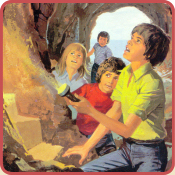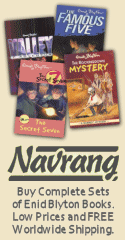
Tim Gets a Chance

Book Details...
First edition: 1968
Publisher: Brockhampton Press
Illustrator: Jacques Fromont
Category: John and Mary
Genre: Family
Type: Short Story Books
Publisher: Brockhampton Press
Illustrator: Jacques Fromont
Category: John and Mary
Genre: Family
Type: Short Story Books
On This Page...
There're a few Boy Next Door characters in the Blyton stable and one that lives in a house adjoining John and Mary's property likes throwing stones at birds. Both children are unhappy about this so they consult their mother and she says the only way for Tim, the boy in question, to be cured of his habit lies in education. Mother has an idea involving a psychological approach whereby Tim will be encouraged not to throw any more stones at birds until they become really tame and then, hopefully, once the boy becomes more acquainted with the creatures his urge to harm them might disappear. The children agree to follow their wise parent's advice.
A few days later Mary is digging in her garden when Tim looks over the wall and spots their robin friend perched on a branch near to where the little girl is working. He tells her that if birds came that close to him he could hit them every time with a stone. Thrusting aside an angry retort, Mary offers to help him achieve his goal. She says that tossing stones at birds won't help to bring them near so if he promises to leave them alone until they become more tame he might have some luck - and in the meantime she and her brother will build him a bird table.
What can Tim say to that?
He promises not to throw anything more at the birds until they begin coming nearer to him, so Mary and John enter his property next day with materials for the construction of a bird table. It's quite a simple operation - first hammer a pole into the ground, which John does, and then attach a flat piece of wood on top. That's also done and a bird table now exists in Tim's garden. Mary instructs him to place a dish of water on top and supply the table with food each day. John also advises him to hang a bone from one end because the tits will love it.
Tim very kindly tells them that he won't annoy any of the birds until they're so tame that he can get up really close to them with his stones.
Isn't that good of him?
Mary doesn't think so and she almost loses her temper upon hearing him say that. She and John return to their own garden deciding to make a table for themselves as well, which they do, and then the children sit back to await results. The first birds to arrive after a day or so are some sparrows that fly down to Tim's table for a few crumbs. The little robin also arrives for a bath, and then several tits show up to demonstrate the acrobatic skills that have been described to thousands of Blytonites over the years. There's a picture of Tim looking through a window at the birds - no doubt sizing them up for a stoning spree.
After about three weeks John says to Tim that his visitors are as tame as the birds that fly down to his own garden so it appears the table has been kept well up to scratch. That very afternoon John and Mary are invited next door to tea, and Tim's friend Chris also joins them. Afterwards they sit down and watch the bird table with its colourful visitors. What a tempting sight that is and before very long Chris urges Tim to fetch his toy gun because shooting them would be a cinch seeing they're fluttering around so close to the children.
What will happen now is worth a guess or two.
Tits are small birds and some, like the 'crested tit,' have fairly distinctive looking heads. They tend to hang round in the Northern Hemisphere and Africa according to sources; the 'tomtit' (tom titmouse) apparently thrives Down Under.
It's a mystery as to what birds get from a bone. Perhaps a few shreds of meat have to be left on it.
Enid Blyton's descriptions in her various books can be used to identify the birds on Tim's table. An educated guess declares a robin (naturally), plus a possible goldfinch, a pair of great tits or maybe they're blue tits - hard to say. There's also what looks like a sparrow, and one that could be a hen blackbird but it might belong to the thrush family. Can't spot the hanging bone.
Other boys in Blyton stories threw stones and inevitably received the necessary education.
John and Mary have really done the rounds so perhaps they're money-spinners. Another compilation containing five of their stories is labelled "High Adventure." It isn't exactly 'High' when series such as the 'Bill Smugs' books are brought into play, but the publications have 'international' connections at the very least. 'High Adventure' was printed by Casterman, the company that produced those beautifully illustrated books about a little girl called 'Martine,' - so Belgium can be added to France (where this particular book was printed), Spain, and England.








